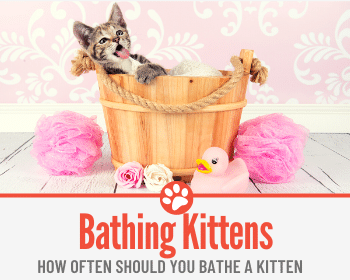 Kittens are very cute and they can also be extremely fragile. It is so important to give them the right care to keep them safe and healthy, there may come a time when you feel that your kitten would benefit from a bath.
Kittens are very cute and they can also be extremely fragile. It is so important to give them the right care to keep them safe and healthy, there may come a time when you feel that your kitten would benefit from a bath.
In this article, we will find out at what age and how often you can actually bathe kittens.
We will also see when and how to bathe a kitten that has fleas.
How often should you bathe a kitten? Can you even give a kitten a bath?
Yes, you can bathe a kitten if you do it in the right way. Kittens of age can be bathed in a tub of water every 4-6 weeks. Kittens do not normally need to be washed, but orphan kittens should be spot-cleaned every time they eat, which is several times a day.
Be careful, because bathing a kitten carelessly and without consideration for their age can be harmful to your furry little friend. There are good reasons why a kitten or cat may benefit from a bath. However, cats are generally self-cleaning animals.
This means that baths are not considered a necessary part of an adult cat’s routine. However, it is very important to wash orphan kittens as they cannot keep themselves clean.
A good reason to give a kitten a bath is to teach them not to be afraid of water from a young age.
As a result, it will be easier to give them necessary baths in later life. If done properly, bathing kittens can be a positive and rewarding experience for them.
What to do when bathing a kitten for the first time
This section is about giving a kitten a full bath in water. To read about taking care of orphan kittens, please read the sections titled Is it bad to bathe a kitten too often? and Can you give a small baby kitten a bath – How soon can you bathe a newborn kitten?
If this is the first kitten-bathing experience for either you or your pet, you or the kitten may feel a bit anxious.
To make yourself feel more confident, be prepared. Familiarize yourself with the process before the event. Make sure you have all your equipment prepared and within easy reach before you start. It may be a good idea to have somebody there to help you.
Your kitten may also feel some anxiety during their first bath. This can depend on their temperament and past experience with water.
If the kitten is very anxious, it is essential to understand why they feel this way, such as if the water is too hot or cold, and do what you can to help them feel safe and secure.
If trying to bathe your kitten turns into a distressing or difficult experience, it is recommended that you talk to your vet for advice. If a bath is really necessary, your vet can give you some tips to help with the bath, or recommend a professional service to do the task for you.
Is it bad to bathe a kitten too often?
For spot bathing of newborn kittens, it is important to clean the kitten every time they eat, which means several times a day. These kittens cannot look after themselves, so it is important to wash them as often as needed to keep them clean.
For full baths, yes, it is unhealthy to bathe them too often. Soaking them too frequently in water can affect the natural balance of their skin and cause irritation. Occasional bathing should help by removing dirt and excess oils trapped under the fur, but it should not keep the cat’s skin dry of natural, healthy oils. Bathing a cat too often can leave the cat’s skin dry and itchy.
Can I bathe my kitten once a week?
No, once a week is much too often to fully bathe a kitten or adult cat. This will cause irritation and disrupt the normal functioning of your cat’s skin.
Can I bathe my kitten once a month?
Basically, yes. This is the limit as to how often you should bathe your kitten in a tub of water, especially if you use kitten shampoo. If you wish to make baths a regular event, then somewhere between every 4-6 weeks is recommended.
Best way to bathe a kitten with fleas
Baths are not the only way to deal with fleas, but they may be considered the best way. One reason why a bath might be necessary for fleas is that non-bath flea treatments made for other animals, or even for adult cats, can be dangerous for kittens.
There are some flea treatments on the market that advertise themselves to be used on kittens. It is important to investigate the specific age range of the treatment to confirm that it is safe for your kitten.
Before needing to bathe your kitten, you may be able to remove the fleas from the kitten’s fur using tweezers. Any fleas should immediately be dropped into a glass of hot, soapy water.
For tips on bathing the kitten, please read the section of this article titled how to give a kitten a bath. In this case, when you place the kitten into the water, the fleas on its body will try to escape by climbing upwards to the kitten’s head.
You can use tweezers to pluck the fleas from the kitten’s head as they move upwards. You can then remove the kitten from the water in a warm room and, while their fur is still damp, go over their body with a flea comb.
Try to do this quickly to avoid leaving the kitten damp and exposed to the air for a long period of time. Their head and face should then be sponged with a piece of cloth or cotton to remove fleas
If you have a flea shampoo that is safe for your kitten, you can use this to create a soapy ring around the kitten’s neck at the start of the bath. This will prevent the fleas from climbing to the kitten’s head.
Soaping the kitten’s body will kill the fleas in those areas. Shampoo can also be added to the cloth used to wipe the kitten’s head, although it is important to keep the soap away from the ears and face.
Make sure to follow other general recommendations for bathing kittens, besides the ones mentioned above.
How often should you bathe a kitten with fleas?
This may depend on whether you have been able to use soap. It might also be necessary to throw away any bedding or other objects that may still harbor fleas waiting to come back to the washed kitten.
If you have used soap, one thorough bath should be enough. If this was not completely successful, or you were only able to wash the kitten with water, it is a good idea to follow this up with light washes. You may continue dampening the fur and brushing it with a flea comb every day, making sure to thoroughly dry and warm the kitten after each wash.
How to Give a Kitten a Bath
This important section explains how to bathe a kitten in a tub of water. Read on for tips about doing this safely to prevent negative effects from the bath. The first step to a bath is preparation. Some people recommend getting your cat used to water in various ways before their first bath. Keep in mind that exposing a kitten’s skin to water can harm young kittens.
That means it is not recommended to splash kittens or pour water over them unless you do it at a safe temperature and followed by drying the kitten carefully.
It is a good idea to clip your kitten’s claws the day before the bath. You will notice that kittens have extremely sharp claws and they will not hesitate to scratch or cling to you if they are anxious. It is also a good idea to brush your kitten’s fur in advance since a lot of shed hair will probably come out during the bath.
Before bath time, make sure to warm up the area, maintain a consistent temperature in the room and keep the area free of drafts. Next, you need to set up the necessary equipment.
This will include two tubs of lukewarm water, a cup or container for scooping water, a non-slip mat (or two, if you will be placing the kitten inside the second tub), specially designed shampoo for kittens like yours, and a couple of towels. You may need a flea comb.
Once the area is set up, it’s time to bring in the kitten. Encourage your kitten and help them to feel safe and secure as you lower them into the lukewarm water.
Make sure you support the kitten’s body and keep their head well above the water. Throughout the bath, keep water away from the cat’s head, including their ears and face. Their head can be washed separately with a piece of wet cloth or cotton without soap.
You might use the cup to pour water over the cat’s body as splashing and spraying cats can be frightening to them. Once the kitten is wet, remove them from the water and apply the shampoo to their body below the neck.
Smooth the shampoo in the direction of hair growth. The kitten can then be placed back in the first tub to wash off the shampoo. The second tub of completely clean water can be used to rinse off any traces of shampoo.
Some people like to keep the kitten in the first tub and scoop clean water over them. Otherwise, it may be easier to place the kitten directly into the second tub for rinsing.
The important thing is to make sure that the kitten’s entire body, including its underside and feet, is washed clean of any soap residue. This is because any soap left on the skin will cause irritation later.
Immediately after the bath is finished, the kitten needs to be dried. First, wrap the kitten in a towel and pat to remove any excess water. Some people prefer to use only towels while others find a hairdryer can help.
If you use a hairdryer here, be sure to keep it on a low setting and hold it at a distance from the cat. Not only can the heat cause damage to the kitten’s skin, but the noise may be frightening.
After thoroughly drying the cat, it is also important to keep them warm for some time following the bath. The kitten should stay in a warm environment without sudden temperature changes for several hours. It is a good idea to keep the kitten wrapped in a towel until it is ready to go back to its normal behavior.
Can you give a small baby kitten a bath? How soon can you bathe a newborn kitten?
While it can be a good idea to give kittens experience with baths, it is important not to soak their skin too early. Kittens do not particularly need to be bathed or washed if they are being raised by their mother cat and are otherwise healthy.
Very small kittens need help to stay clean, and the mother cat does this naturally by licking them. However, kittens raised without a mother can become very messy if they are not looked after carefully.
Orphan kittens need help staying clean and should be washed throughout the day.
When & from what age can you give a kitten a bath?
Kittens are not ready to be immersed in water until about two months of age because they have very little body fat. This means they cannot thermo-regulate. Putting a very young kitten in water makes them vulnerable to dangerous temperatures.
This helpful summary from Kitten Coalition gives helpful information about newborn kittens and changes to their body temperature.
Below two months, kittens should be spot cleaned with a cloth, and only if needed. Orphan kittens, in particular, need to be cleaned several times per day. Each time the kitten feeds, it should be brushed in the direction of its fur with a warm, damp cloth.
This will stimulate its bowels. You should then wipe the kitten’s backside with a separate cloth before cleaning the area again with a warm, damp cloth.
1-week-old kitten
A kitten will need to be cleaned at this age, but they are not ready to be fully placed in water. Orphan kittens should be spot cleaned with a damp cloth. This should occur every time they eat, which is every two hours at this age.
If the kitten gets very messy and absolutely needs to be cleaned with more water, the affected area may be placed under lukewarm running water, although it is very important to dry the kitten properly and keep it warm.
2-week-old kitten
At this age, kittens are still not ready for a full bath. Orphans still need to be spot cleaned after eating. By now, they may start eating every 3-4 hours. A damp cloth affects the kitten’s fur without soaking the skin, and is similar to the way that a mother cat will clean her kittens.
The kitten’s fur should be dried with a towel. Once again, the kitten can be placed under running water if needed, but this should be done very carefully.
3-week-old kitten
These kittens are still at risk when exposed to water. For this reason, bathing is still only recommended if really necessary.
Their feeding schedule will be similar to that of 2-week-old kittens and they need to be cleaned accordingly. You may notice that kittens of this age start licking themselves.
However, they will not be able to keep themselves clean, which means you will need to help them when feeding every 3-4 hours.
6-week-old kitten
By six weeks of age, kittens are able to clean themselves and no longer need daily spot cleaning. They are also about ready to start having a full bath, although this is still generally not recommended until eight weeks.
Bathing long-haired kittens
How often should you bathe a Persian kitten
Like any other cat, you can bathe a Persian kitten every month or so, but no more frequently than that. As long-haired cats, Persians need regular brushing and grooming as well. It is a good idea to brush them every day.
Bathing is a good way of removing shed hair, which helps prevent hairballs and matting of their coat. It also helps keep their fur smooth and untangled. It is a good idea to dilute shampoo before pouring the soapy water over the cat.
Concentrated shampoo can turn long hair into a lathery mess. Cat conditioner may be necessary to prevent the hair from becoming tangled and knotted. The excess water needs to be squeezed out before you can towel-dry the kitten.
How often should you bathe a Ragdoll kitten
Ragdolls may be given a bath no more than once a month. Once again, grooming a Ragdoll regularly is more important than bathing them. Ragdolls should be brushed a few times a week.
Like Persians, Ragdolls are unlikely to be very dirty or have parasites since they are unadventurous cats. This means they don’t tend to pick up bugs and dirt in their fur like many other cats do while exploring. Ragdolls should be bathed in much the same way as Persians.
What to do if kitten is acting strange after a bath
Kittens are usually relaxed, and probably relieved, when their bath is finished. After a bath, a kitten should be wrapped up warmly and not exposed to any cold or drafty environments. Once the kitten is completely dry and has been kept warm for a significant period of time after their bath, they will eventually return to their normal behavior.
If your kitten appears anxious after their bath, they may have been traumatized by their bathing experience. If your kitten appears to be uncomfortable, distressed or unwell after their bath, it is important to find out why this may be the case and do what you can to make your cat comfortable.
It is essential to keep the kitten warm and dry after a bath. If you think your kitten may have been affected by a chill or any other negative side-effects, you may need to contact an emergency vet for advice.
Can a kitten die from a bath?
Yes, while this is not a normal outcome of bathing kittens, there is certainly a risk that your kitten can become very sick or die if the proper care is not taken. This is why it is so important not to bathe kittens until a certain age unless necessary, to stay away from harmful chemicals, to use lukewarm water, and to dry the kitten thoroughly after a bath.
Bathing your kitten keeps them healthy and clean, and makes future baths a much easier experience. Don’t be afraid to bathe your kitten if you do it in the right way. As always, take it as a great opportunity to bond with your kitty and show them that you care.


